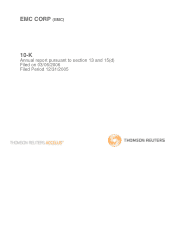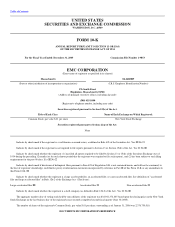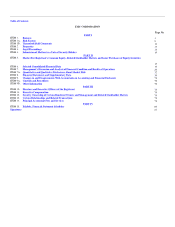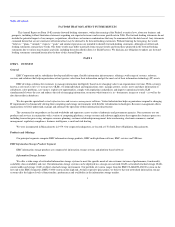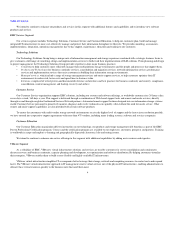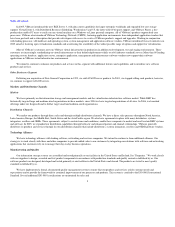EMC 2005 Annual Report Download - page 9
Download and view the complete annual report
Please find page 9 of the 2005 EMC annual report below. You can navigate through the pages in the report by either clicking on the pages listed below, or by using the keyword search tool below to find specific information within the annual report.
Table of Contents
In 2005, VMware introduced the new ESX Server 3, with data center capabilities for larger enterprise workloads and expanded low cost storage
support; VirtualCenter 2, with Distributed Resource Scheduling; Workstation 5 and 5.5, the latter with 64-bit guest support; and VMware Player, a free
product that enables PC users to easily run any virtual machine on a Windows or Linux personal computer. All of VMware's products support dual-core
processors. VMware also introduced VMware Technology Network (VMTN), featuring application environments from independent application vendors that
have been pre-built and a subscription that provides developers with access to a suite of VMware products, support and upgrades. Working in conjunction
with leading processor, x86 hardware and operating system, system management and application software vendors, VMware introduced two new initiatives in
2005 aimed at fostering open virtualization standards and accelerating the availability of the widest possible range of options and support for virtualization.
Most of VMware's customers now run VMware virtual infrastructure in production in addition to development, test and staging environments. These
customers are increasingly standardizing on virtual infrastructure as their default deployment vehicle on x86 (industry-standard) servers. More than 60 leading
operating system, database, application server, enterprise application, management and infrastructure software vendors now support their software
applications in VMware virtual infrastructure environments.
We intend to continue to enhance our products and services in this segment with additional features and capabilities and to introduce new software
products and services.
Other Businesses Segment
Following our acquisition of Data General Corporation in 1999, we sold AViiON server products. In 2001, we stopped selling such products; however,
we continue to support AViiON servers.
Markets and Distribution Channels
Markets
We focus primarily on the information storage and management markets and the virtualization infrastructure software market. While EMC has
historically targeted large and medium-sized organizations in these markets, since 2004 we have targeted organizations of all sizes. In 2006, we launched
offerings under our Insignia brand to further target small and medium-sized organizations.
Distribution Channels
We market our products through direct sales and through multiple distribution channels. We have a direct sales presence throughout North America,
Latin America, Europe, the Middle East, South Africa and the Asia Pacific region. We also have agreements in place with many distributors, systems
integrators, resellers and OEMs. These agreements, subject to certain terms and conditions, enable these companies to market and resell certain EMC systems
and software. In 2005, we expanded our distribution capabilities through both new and enhanced partner and channel relationships. VMware generally
distributes its products and services through its own distribution channels that include distributors, systems integrators, resellers and OEM hardware vendors.
Technology Alliances
We have technology alliances with leading software, networking and services companies. We intend to continue to form additional alliances. Our
strategy is to work closely with these and other companies to provide added value to our customers by integrating our solutions with software and networking
applications that customers rely on to manage their day-to-day business operations.
Manufacturing and Quality
Our information storage systems are assembled and tested primarily at our facilities in the United States and Ireland. See "Properties." We work closely
with our suppliers to design, assemble and test product components in accordance with production standards and quality controls established by us. Our
software products are designed, developed and tested primarily at our facilities in the United States and abroad. The products are tested to meet quality
standards established by us.
We have implemented a formal, documented quality management system to ensure that our products and services satisfy customer needs and
expectations and to provide the framework for continual improvement of our processes and products. This system is certified to the ISO 9001 International
Standard. Several additional ISO 9001 certifications are maintained for sales and
5

